QuestionQUESTION: Hi - My cat brought in a wild baby rat and then dropped it. He scurried away and it turns out the little guy/girl wasn't hurt and since I have pet rats already, I scooped him up and put him in the baby cage. He's been here 2 days and seems to be doing fine. I looked at the website that shows baby rats aging, and I think he's about 18-21 days old. His eyes are open and he has fur, but he's very tiny; his tail is only about 2.5 inches long. I put the heating pad under one end of the cage, put in a small igloo, some soft rags, put both a water bottle and some water in one of the rattie crocks, and put in some small pieces of Mazuri lab blocks. The next day I could see that he had eaten some lab blocks and taken some water, too. I have access to fresh goat milk, so I put a little of that in and he drank some of that, too. I'm not sure about the goats milk tho; I've never given any of my other rats any kind of milk. I took him out yesterday and after letting me hold him for about 30 seconds he took off like lightning and it took me awhile to coax him into the cup so I could put him back in the cage. He's quarantined from my other ratties and I wash my hands after holding him or being in his cage so my own babies don't get anything. I thought I'd keep him for a few weeks, then let him go, but I had reservations about that and now I've read here that he won't know how to survive. And I know he can't go in with my domesticated babies, plus they are old and it wouldn't do. I don't want him to have to live alone. How can I get a buddy for him? I don't think the wilds and domesticated rats get along together. Is that true even if they are put together at a young age? I don't normally get pet store rats anymore, but I could if it would mean my wild guy would have a buddy. Do you have any advise for me on the goats milk and the buddy thing? Any any other wisdom about wild rats would be appreciated. Thank you.
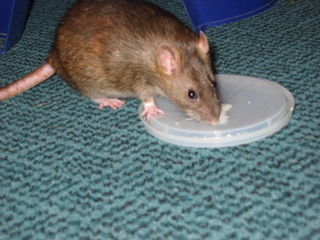 Holly licking some yog
Holly licking some yog
ANSWER: Congrats! Your now the proud owner of a wild rat.
I had one myself....my sweet Holly who lived to be nearly 4 years old. I acquired her at 11 weeks of age, the biter that she was, and worked hard for a week trust training her. As for getting them with other rats, you would need to do it now with a tiny baby close to the wild ones age. The good news is that they do well alone. Pack rats at first, they die so easily many wild rats end up solo and do not become lonely like our fancy rats do. Treat him as you would the pet rats: same food, bedding, cage, but remember he will be more timid since he just now came to know about humans. He is still able to come down with respiratory disease related to mycoplasmosis (all rodents are born to it, wild or domesticated) and females still can get the nasty mammary tumors (males do too but not as common) He may walk different, taking long strides when running (as an adult) have a longer snout, wide set eyes that may slant more, larger ears and a longer tail but he still is pretty much like our domestics. Some vets are funny about wild life so just do not share the fact he is wild hybrid should he need a vet. It doesnt matter anyhow so its best not to share just to be safe or the vet who may feel there is a difference in the two rats may not want to treat him. If the vet is a board certified exotic vet, he may not mind knowing there is no difference. Outsiders may start with horror stories saying this or that about disease, again IGNORE them. . Its not true. I would suggest quarantine for any rat brought into the home, domestic or wild hybrid. He should not be released to the wild because as you said, he will have no idea how to forage for food and water and will die fast.
He needs some TLC in order to trust so be patient...thats all you need to do is gently speak to him, let him come to you, let him lick baby food from your fingers, moisten his blocks a bit so he can eat them easier. Do you have a photo of him?
Here is my girl Holly. I will show you a photo of a litter of wild babies a friend raised that also did well alone (she found homes for each of them)
My wild girl was one of the best rats I have ever had!!
If you want to try to find a very young male rat, they may introduce just fine, but it needs to be young too. If not though, it is not a problem like it would be if he were domesticated.
Oh, the goats milk? Try soy instead.
---------- FOLLOW-UP ----------
QUESTION: Thanks for the info and the pic of your wild Holly girl - she's adorable. Since she was a biter, how did you protect yourself from bites? Gloves have worked for me in the past, but I don't like them because I can't feel my animal with them on, and I'm afraid I'll mishandle them by not being able to feel them. I had a biter rattie girl myself years ago and my fingers had wounds on them of varying degrees of healing all the time. I reached in for this little wild guy (might be a girl; I see no evidence of guy stuff yet) earlier today and was able to pet him for a few minutes. But tonight when I reached in to do the same, he did bite me. Didn't break the skin, but his bite was stronger than the first day he was here with us. Guess he's getting stronger. Also, shouldn't I be seeing signs of boyness in him by now, or is it too early? I've had many boy ratties, so I know what to look for. :) Just not sure how early the evidence shows up. I'll see if I can get a pic of him/her tomorrow, but he/she may not come out enough to get one. Thanks for all the info. It's been a great help.
Answer
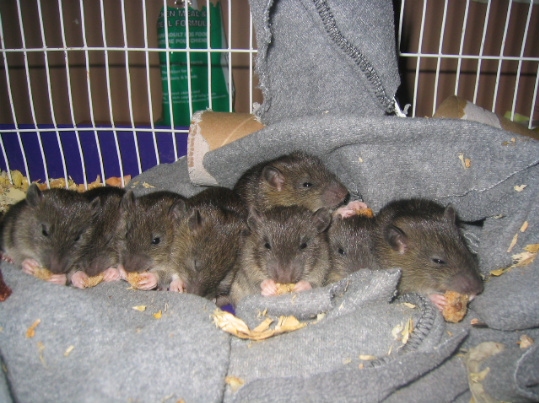 baby wild rats
baby wild rats
I did not use gloves. I wanted Holly to learn my scent and the gloves would only confuse her.
During her time out, I had her in a play area with toys etc....the play area was made using 4 foot cardboard sheets. See my website here for info on how to make one:
I would add some toys and myself and let her come out of her cage, but never picking her up. She would bite me when I would try to handle her.
After a while I would try to pet her and if she bit me, back in the cage she went, playtime over.
A few hours later I went back and tried again. If we made it for the full 20 minutes with no biting, she would be rewarded with a treat. If she bit me, no treat. She hated being put back and looked forward to her time out, even though she spent alot of time running from box to box to hide from me. She soon realized biting got her back in the cage without a treat but positive rewards came when she did not bite me. It took a good week or so but she learned what I wanted from her. I also let her lick baby food from my fingers so she learned to trust my hands too.
About a year ago someone wrote to me about a rat that lived within the walls of her Cafe. They finally caught the rat and brought her to their home keeping her in the cage. Turns out she had babies so here this lady was, no experience with rats at all, and she was facing a litter of wild baby rats. We found homes for all of the babies and mother rat, too, since the lady found out she was severely allergic to rats. Check their photo out here, eating peanuts. They were adorable!



 small red bubble on face
QuestionQUESTION: hi my rat has a small red bubble like
small red bubble on face
QuestionQUESTION: hi my rat has a small red bubble like
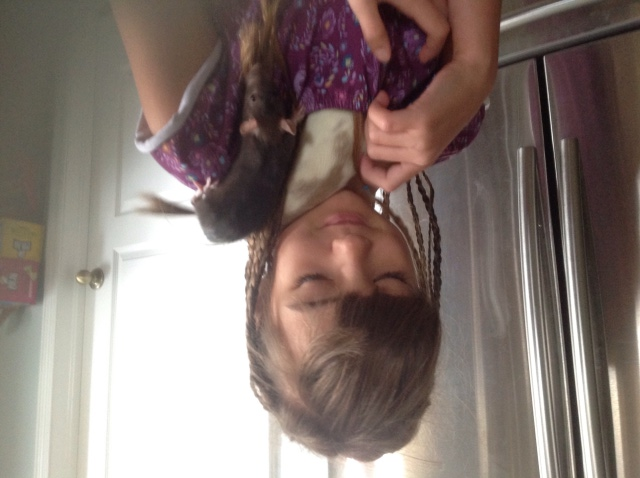 Cookie & Stella
Question
Cookie and Stella
Hi Irene,
Things are
Cookie & Stella
Question
Cookie and Stella
Hi Irene,
Things are
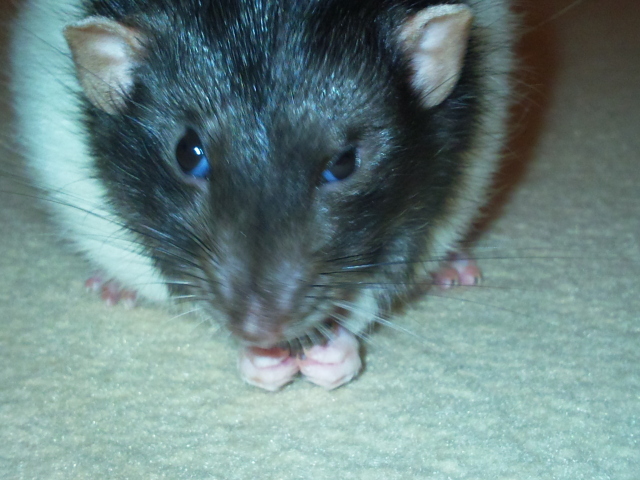 Lump above pet rats eye and one eye sticking out more than the other
QuestionQUESTION: Hello.
We have a pet Dumbo rat and h
Lump above pet rats eye and one eye sticking out more than the other
QuestionQUESTION: Hello.
We have a pet Dumbo rat and h
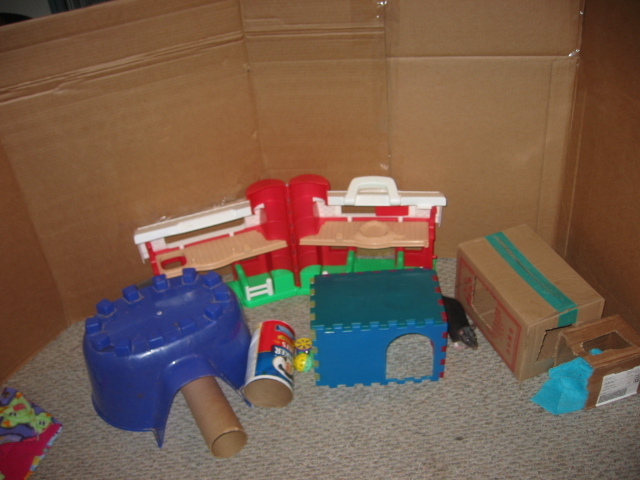 Hyperactive rat?
QuestionMy girlfriend and I have recently bought two fe
Hyperactive rat?
QuestionMy girlfriend and I have recently bought two fe
 Saved wild baby rat
QuestionQUESTION: Hi - My cat brought in a wild baby ra
Saved wild baby rat
QuestionQUESTION: Hi - My cat brought in a wild baby ra